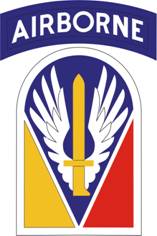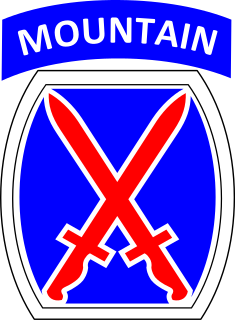Fort Hood is a U.S. military post located in Killeen, Texas. The post is named after Confederate General John Bell Hood who is best known for commanding the Texas Brigade during the American Civil War. It is located halfway between Austin and Waco, about 60 miles (97 km) from each, within the U.S. state of Texas. Fort Hood is an installation of the United States Army.

The 3rd Infantry Division is a combined arms and light infantry division of the United States Army based at Fort Stewart, Georgia. It is a direct subordinate unit of the XVIII Airborne Corps and U.S. Army Forces Command. Its current organization includes one Infantry and two armored brigade combat teams, one aviation brigade, a division artillery and support elements. The division has a distinguished history, having seen active service in both World War I and World War II.

The 1st Armored Division—nicknamed "Old Ironsides"—is a combined arms division of the United States Army. The division is part of III Corps, with its base of operations in Fort Bliss in El Paso, Texas. It was the first armored division of the U.S. Army to see battle in World War II.

The 2nd Infantry Division is a formation of the United States Army. Its current primary mission is the defense of South Korea in the initial stages of an invasion from North Korea until other American units can arrive. There are approximately 17,000 soldiers in the 2nd Infantry Division, with 10,000 of them stationed in South Korea, accounting for about 35% of the United States Forces Korea personnel.

The 509th Infantry Regiment is an airborne infantry regiment of the United States Army. Previously titled the 509th Parachute Infantry Regiment, it was the first parachute infantry unit of the U.S. Army to make a combat jump during World War II. Currently its 1st and 3rd battalions are active. The 1st Battalion serves as the Opposing Force (OPFOR) at the Army's Joint Readiness Training Center at Fort Polk, Louisiana. The 3rd Battalion is assigned to the 4th Brigade Combat Team (Airborne), 25th Infantry Division, at Fort Richardson, Alaska.

Fort Polk is a United States Army installation located in Vernon Parish, approximately ten miles east of Leesville, Louisiana, and thirty miles north of DeRidder in Beauregard Parish, Louisiana.

United States Army Forces Command (FORSCOM) is the largest United States Army command and provider of expeditionary, regionally engaged, campaign-capable land forces to combatant commanders. Headquartered at Fort Bragg, North Carolina, FORSCOM consists of more than 750,000 active Army, U.S. Army Reserve, and Army National Guard soldiers. FORSCOM provides enhanced land power gaining operational depth and versatility through a mix of fully integrated Active and Reserve Component forces operating in a joint, interagency, intergovernmental, and multinational (JIIM) environment. Its organizations are expeditionary, campaign focused, and tailorable to provide combatant commanders the required capabilities to be decisive across the range of military operations. FORSCOM was created on July 1, 1973, from the former Continental Army Command (CONARC).

The reorganization plan of the United States Army is a current modernization and reorganization plan of the United States Army that was implemented under the direction of Brigade Modernization Command. This effort formally began in 2006 when General Peter Schoomaker, was given the support to move the Army from its Cold War divisional orientation to a full-spectrum capability with fully manned, equipped and trained brigades. This was the most comprehensive reorganization since World War II and included modular combat brigades, support brigades, and command headquarters, as well as rebalancing the active and reserve components. The plan was first proposed by Army Chief of Staff, Eric Shinseki, in 1999, but was bitterly opposed internally by the Army.

The 2nd Brigade Combat Team, 10th Mountain Division is an infantry Brigade Combat Team of the United States Army based at Fort Drum, New York. It is a subordinate unit of the 10th Mountain Division.

The 188th Infantry Brigade is an infantry training brigade of the United States Army based at Fort Stewart, Georgia. It is a subordinate unit of the First United States Army, Division East.
82nd Field Artillery Regiment is a field artillery regiment of the United States Army. The regiment has been involved with American conflicts dating back to then US involvement in the Mexican Civil War and more recently with the War on Terrorism. Currently, there are two active and three inactivate battalions in the regiment. Traditionally, the regiment has been aligned with the 1st Cavalry Division at Fort Hood, Texas and Fort Bliss, Texas.

MISSION

The 4th Brigade Combat Team, 1st Armored Division "Highlanders", is an armored brigade combat team (ABCT) of the 1st Armored Division, United States Army. The brigade is mechanized and its major combat equipment include the M1A2SEP Abrams tank, M2A3 & M3A3 Bradley infantry fighting vehicle, M109A6 Paladin howitzer, M1151 HMMWV and MRAP.
The U.S. 41st Infantry Regiment is a regiment of the United States Army. Its 1st Battalion is currently assigned to the 2nd Infantry Brigade Combat Team, 4th Infantry Division. Its 3rd Battalion is assigned to the 1st Stryker Brigade Combat Team, 1st Armored Division.

The 4th Brigade Combat Team, 1st Infantry Division is an inactive Infantry Brigade Combat Team. Active from 2006 through 2015, the BCT served in Iraq from 2007-2008 and from 2009-2010, in Afghanistan from 2012-2013, and in a variety of theater security cooperation activities in Africa from 2014-2015. The BCT was inactivated in 2015 as part of force reductions.
The 2nd Battalion, 29th Field Artillery Regiment is a unit of the 4th Armor Brigade Combat Team of the 1st Armored Division, United States Army. The battalion is currently garrisoned at Fort Bliss, Texas.

The 3rd Stryker Brigade Combat Team, 2nd Infantry Division is an inactive Stryker Brigade Combat Team of the United States Army's 2nd Infantry Division.

The 44th Infantry Brigade Combat Team is an infantry brigade combat team of the United States Army National Guard of New Jersey. It is headquartered at the Lawrenceville Armory in the Lawrenceville section of Lawrence Township in Mercer County, New Jersey, United States.
























